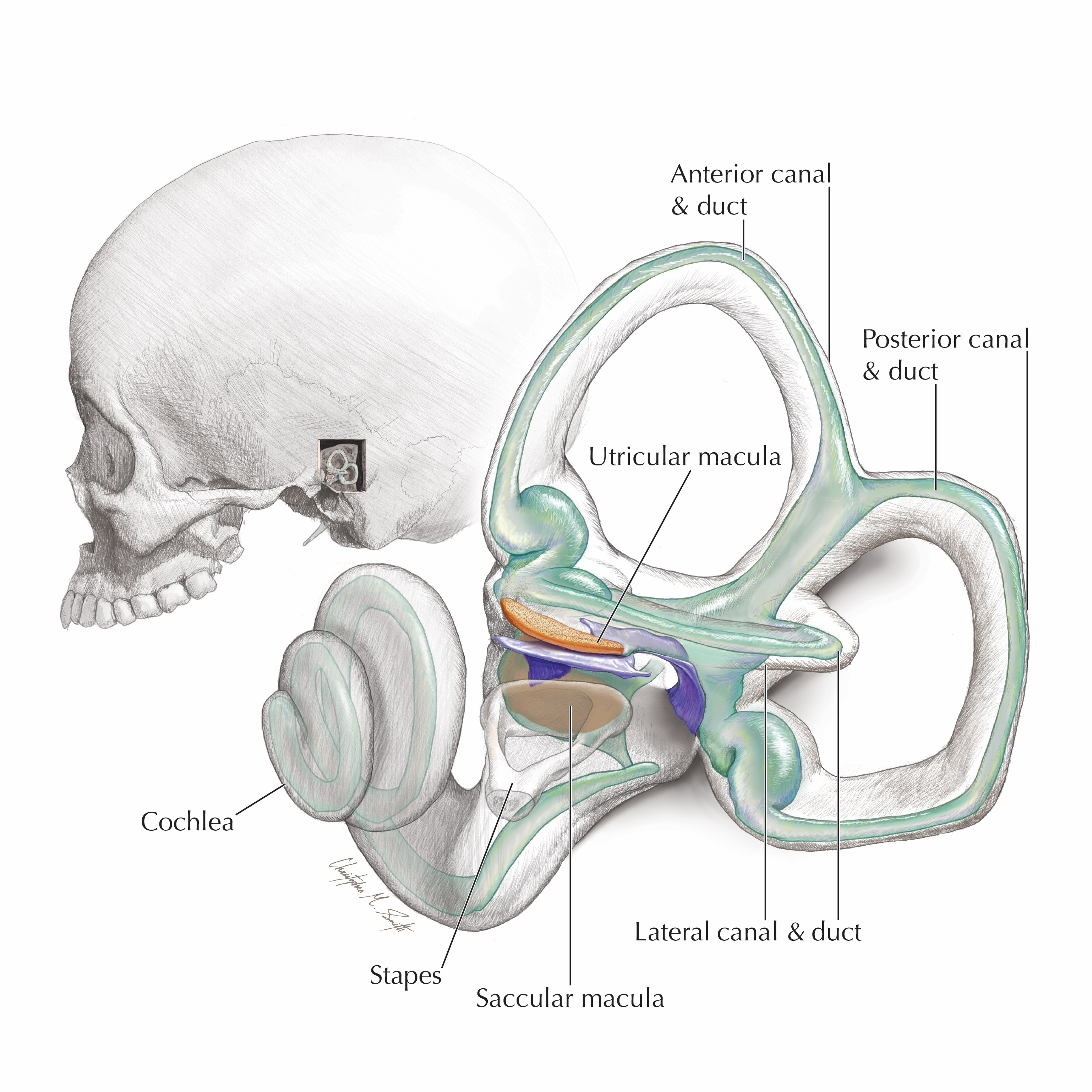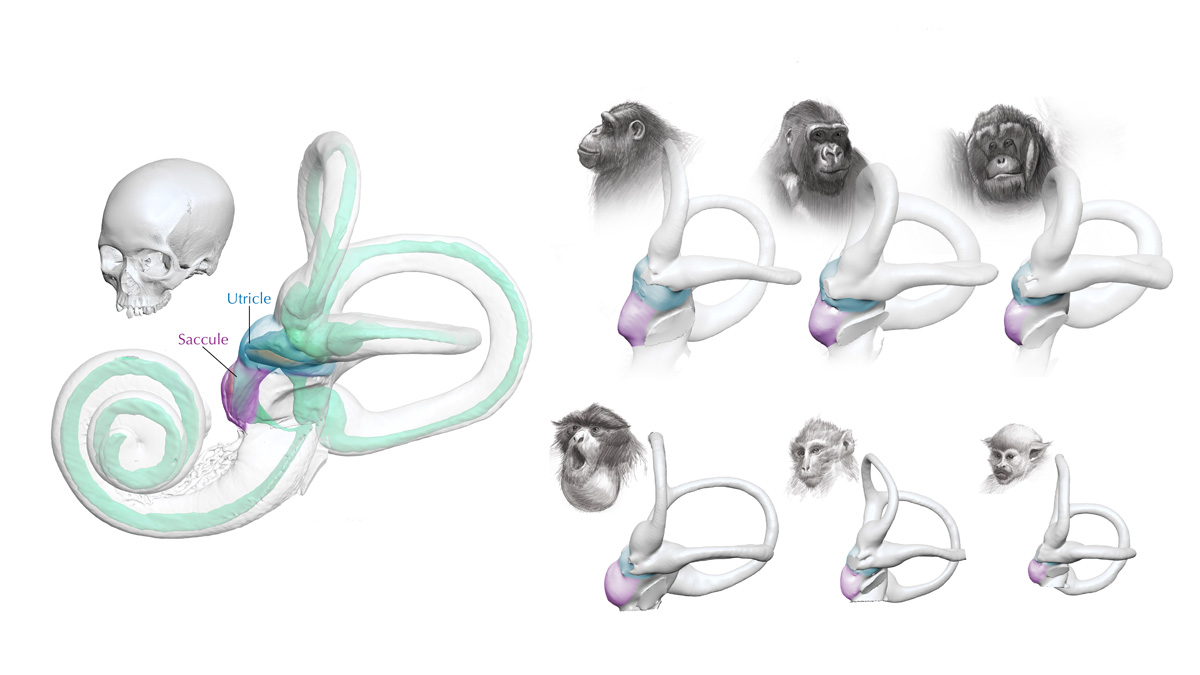Beyond Hearing: Exploring the Evolutionary Secrets of the Human Inner Ear
Published in Ecology & Evolution, Neuroscience, and Anatomy & Physiology

When we think of essential components of human anatomy, the ear is often overlooked. Yet, it is far more than a mere accessory for earrings or a conduit for our favorite tunes. The ear is fundamental to our everyday life. Nestled deep within our skull lies the “labyrinth” (a network of passageways also known as the inner ear), which serves roles far beyond just hearing.
The balance system of the ear (known as the vestibular system) comprises five sensory organs that provide our sense of spatial awareness, enabling gaze stabilization, motor coordination, and navigation through our environment. We often take this "extra" sense for granted, only realizing its significance when something goes wrong, as anyone who has endured the disorienting effects of vertigo can confirm.
Remarkably, the inner ear is a world unto itself, tracing its origins back over 500 million years to the dawn of vertebrates. What’s even more fascinating is that this system continues to evolve, offering vital insights into the evolutionary changes that have shaped our own lineage. The inner ear is not just an anatomical feature; it is a window into our past and a key to understanding our present.

Before I became a scientist, I was a fine artist and illustrator. Exploring the natural world through creative expression was my gateway into science. It is because of my background as an artist that I fell in love with the mystery, complexity, and beauty of the inner ear. It was while taking human gross anatomy during graduate school at Johns Hopkins that I first became fascinated with this structure. However, dissecting the ear is quite challenging, and, like most medical schools, it was primarily taught through imaging and illustrations. This limitation only deepened my curiosity and set me on a journey to explore this enigmatic region of the body further.
In paleontology, the inner ear is traditionally used to reconstruct aspects of locomotion and hearing in fossil species. Yet, one area remains particularly elusive: the otolithic organs, which are responsible for detecting linear acceleration and gravity. The challenge lies in the bony “shell” surrounding these organs, known as the vestibule, which is believed to offer little to no insight into the internal structures themselves. As a result, the vestibule is often dismissed in reconstructions of fossil behavior. This gap in our understanding represents a significant hurdle in unraveling the complexities of neurosensory evolution.
This paper traces its origins back to late 2018 when, during a discussion with my doctoral advisor, Jeffrey Laitman, it became apparent that this area of the inner ear is equivalent to a “black box” in mammalian evolutionary anatomy. Just trying to describe the organ morphology is difficult, let alone interpreting bony structure. Ever the one to encourage outside of the “box” thinking, Professor Laitman proposed a challenge: figure out how to visualize the otolithic system in a way that incorporates both the internal organs and their bony shell. If successful, this would open new avenues to study the evolution of sensory biology. In particular, since these organs are gravity sensors in mammals, the idea was that if we could find a way to document functional morphological change, we could learn more about shifts in postural behavior. I thought about this for quite a long time before I eventually accepted the challenge and dedicated the next few years of my life to tackling this problem.
The first step was to determine if there was, indeed, any relationship between the otolithic organs and surrounding bony vestibule. My dissertation tested this by visualizing and modeling the relationships between the internal membranous and external bony anatomy of the vestibule. That work ultimately confirmed the relationship and established a suite of bony features that reliably track with that of the otolithic organs (see Smith et al. 2022, 2023).
Our study now expands on the above work and applies what we’ve learned about inner ear morphology to answer the following questions: 1) Is there evidence for evolutionary change in the otolithic system of apes and humans?; and 2) if so, might this reflect differences in postural behavior?

Our results reveal a remarkable amount of diversity in the ape and human group (known as hominoids). While gibbons and siamangs evolved their own distinct morphology, the great ape and human group (known as hominids) evolved other distinguishing shapes of the vestibule. It is from this great ape-like morphology that we see a departure of both humans and chimpanzees, diverging from their last common ancestor. When we dig in deeper as to what might be causing this difference, we find a potential link with head and neck posture, specifically how the neck is orientated relative to gravity. While there remains much to explore (including why humans and squirrel monkeys share such similar morphology, and what might be causing the divergence in hylobatids), this study provides new tantalizing glimpses into neurosensory change in apes and humans and provides the foundation to further explore the evolution of behavior using this enigmatic region of the inner ear.
I’d like to acknowledge that this work is the result of a collaboration with my co-authors Romain David, Sergio Almécija, Jeffrey Laitman, and Ashley Hammond. Each has contributed their expertise and resources to make this project possible, and I am grateful for their willingness to dive further into the depths of the “labyrinth” with me.
Follow the Topic
-
Communications Biology

An open access journal from Nature Portfolio publishing high-quality research, reviews and commentary in all areas of the biological sciences, representing significant advances and bringing new biological insight to a specialized area of research.
Related Collections
With Collections, you can get published faster and increase your visibility.
Stem cell-derived therapies
Publishing Model: Hybrid
Deadline: Mar 26, 2026
Forces in Cell Biology
Publishing Model: Open Access
Deadline: Apr 30, 2026





Please sign in or register for FREE
If you are a registered user on Research Communities by Springer Nature, please sign in